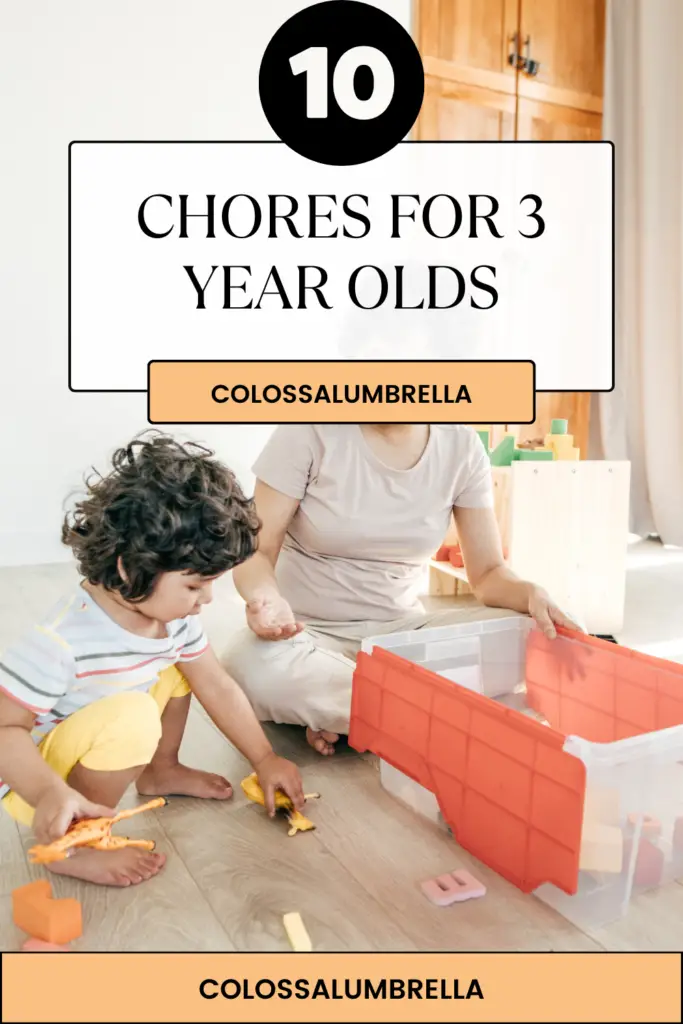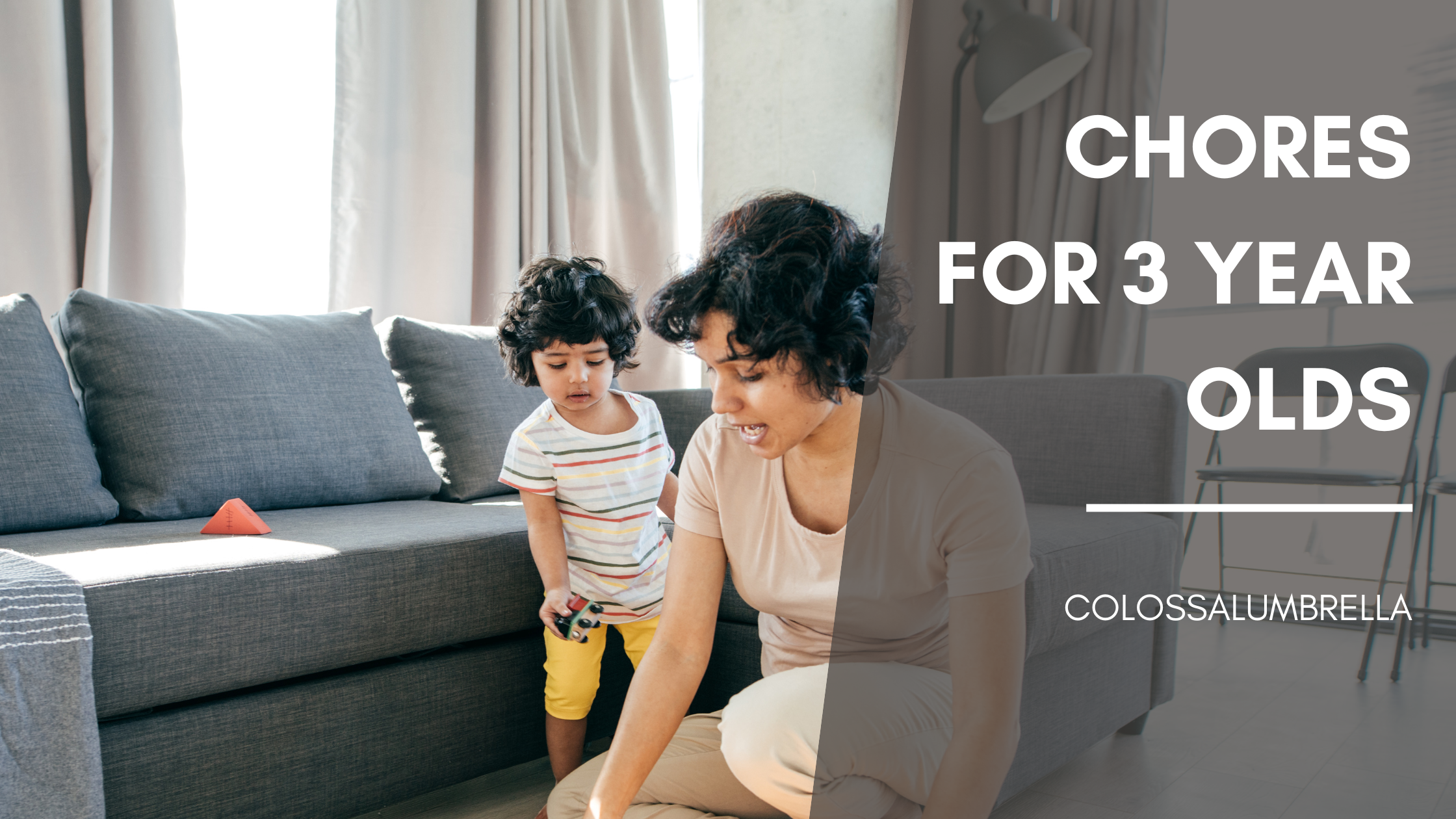Contents
Introducing chores at a young age lays the foundation for responsibility and independence in children. Engaging 3-year-olds in household tasks not only teaches them valuable life skills but also fosters a sense of contribution and belonging within the family unit. In this blog post, we will explore various Chores for 3 Year Olds, considering their cognitive and motor development. By involving them in age-appropriate tasks, we can help them build important skills while making chores a fun and rewarding experience.
Understanding the capabilities of 3 year olds
Before diving into specific chore ideas, it’s essential to understand the developmental stage of 3-year-olds. At this age, children are rapidly expanding their cognitive abilities. They have a growing curiosity and are eager to learn and explore their surroundings. Additionally, their fine and gross motor skills are developing, allowing them to perform tasks that involve hand-eye coordination and physical movements.
What is the best age to start giving children chores?
Determining the best age to start giving children chores can vary depending on the child’s individual development and maturity. However, it is generally recommended to begin introducing age-appropriate chores around the age of 2 to 3 years old. At this stage, children are starting to develop basic motor skills, cognitive abilities, and a growing sense of independence.
Chores for 3 year Olds
Sorting and matching socks
Teaching 3-year-olds to sort and match socks not only helps with keeping the laundry organized but also develops their organizational skills. Encourage your child to identify matching pairs of socks based on colors, patterns, or characters. This activity enhances their visual discrimination abilities, promoting attention to detail and critical thinking.
Setting the table
Involving your 3-year-old in setting the table for meals is an excellent way to teach them about mealtime routines and enhance their hand-eye coordination. Start by assigning simple tasks, such as placing napkins or utensils on the table. As they progress, you can introduce more responsibilities, such as placing plates and cups. This activity also encourages them to feel involved in the family mealtime experience.
Watering plants
Watering plants is a task that can instill a sense of responsibility and care in young children. Provide your child with a small watering can and guide them to water indoor or outdoor plants. This activity not only helps them understand the needs of living things but also develops their fine motor skills as they manipulate the watering can and pour water carefully.
Assisting with pet care
If you have pets at home, involving your 3-year-old in pet care activities can be both educational and rewarding.
Feeding pets
Assigning your child the responsibility of feeding pets encourages empathy and compassion. Teach them about the importance of regular feeding schedules and portion sizes suitable for the specific pet. Supervise and guide them as they pour the appropriate amount of food into the pet’s bowl, ensuring they understand the concept of routines and providing for others’ needs.
Brushing pets
Brushing pets is an activity that enhances sensory exploration and fosters empathy towards animals. Show your child how to gently brush the pet’s fur using a pet-friendly brush. Explain the importance of being gentle and considerate towards the pet’s comfort. This task also presents an opportunity to discuss the importance of grooming and taking care of living creatures.
Tidying up toys
Teaching 3-year-olds to tidy up their toys helps instill a sense of orderliness and responsibility.
Sorting toys into categories
Guide your child to sort their toys into categories, such as dolls, cars, or building blocks. This activity helps them develop cognitive skills through classification, promoting logical thinking and organization. Encourage them to place each group of toys in designated bins or shelves, making it easier for them to find and retrieve their toys independently.
Cleaning up spills and messes
Accidents happen, and spills and messes are part of everyday life. Involve your child in the process of cleaning up spills by providing them with child-sized cleaning tools, such as a small broom and dustpan or a spill-absorbent cloth. This activity cultivates a sense of responsibility as they learn to take ownership of their actions and contribute to maintaining a clean environment.
Assisting with laundry
Getting 3-year-olds involved in laundry tasks can be a fun and educational experience.
Matching socks and folding clothes
Engage your child in the process of matching socks and folding clothes. Show them how to identify pairs of socks and fold items neatly. This activity strengthens their visual perception skills and introduces them to basic folding techniques. Celebrate their accomplishments as they successfully match socks or fold small garments, reinforcing their participation in household tasks.
Putting away clean laundry
Teach your child to put away their clean laundry in designated drawers or shelves. This chore helps them learn about organization and cleanliness while improving their fine motor skills as they handle and sort clothing items. Start with simple clothing pieces like socks or pajamas and gradually introduce more complex folding and organizing tasks as they become more proficient.
Dusting and wiping surfaces
Engaging 3-year-olds in dusting and wiping surfaces introduces them to the concept of cleanliness and contributes to maintaining a tidy living space.
Using a duster or cloth
Provide your child with a child-sized duster or cloth and show them how to dust surfaces like shelves, tables, or low furniture. This task enhances their hand-eye coordination as they learn to maneuver the duster across various surfaces. Explain the importance of removing dust and keeping the environment clean for better hygiene and aesthetics.
Wiping surfaces with a damp cloth
Teach your child how to wipe surfaces with a damp cloth to remove dirt and smudges. This activity reinforces the significance of cleanliness and offers an opportunity to discuss the importance of maintaining a sanitary living space. Guide them to wipe surfaces gently, ensuring they understand the difference between clean and dirty areas.
Taking care of personal belongings
Involving 3-year-olds in taking care of their personal belongings encourages independence and ownership.
Putting away shoes and jackets
Encourage your child to put away their shoes and jackets in designated areas upon returning home. This simple chore fosters independence and self-sufficiency as they learn to take responsibility for their belongings. Additionally, it helps them develop spatial awareness by recognizing the appropriate storage locations.
Organizing personal items
Guide your child to organize their personal items, such as toys, books, or art supplies. Provide labeled bins or shelves to assist them in categorizing and storing their belongings. This activity builds organizational skills and reinforces their sense of ownership over their possessions.

Role-playing and pretend chores
Engaging in role-playing and pretend chores for 3 year olds allows them to exercise their imagination and creativity while learning valuable life skills.
Toy kitchen or tool set activities
Encourage your child to engage in imaginative play with toy kitchens or tool sets. Role-playing scenarios such as cooking, cleaning, or fixing things allow them to explore different household chores for 3 year olds in a playful and enjoyable manner. This activity promotes creativity, problem-solving, and an understanding of the tasks performed in daily life.
Doll or teddy bear care routines
Introduce your child to doll or teddy bear care routines. Provide them with miniature cleaning tools and encourage them to pretend to clean, dress, or feed their dolls or stuffed animals. This pretend play nurtures empathy, nurturing skills, and a sense of responsibility towards others.
Safety considerations and supervision
When involving 3-year-olds in chores, it’s crucial to prioritize their safety and provide appropriate supervision.
- Providing a safe environment – Ensure the areas where chores are performed are childproofed and free from potential hazards. Store cleaning supplies and tools out of their reach, and use child-friendly alternatives when necessary. Create a safe and conducive environment that promotes independent participation in chores.
- Supervising 3-year-olds during chores – While encouraging independence, it’s essential to supervise 3-year-olds during chores to offer guidance and support. Be present to assist with tasks that may require additional help or demonstrate techniques as needed. Celebrate their achievements and progress, reinforcing their sense of accomplishment and motivation to continue participating in household responsibilities.
Conclusion
Introducing age-appropriate chores for 3 year olds provides a multitude of benefits. By involving them in tasks that align with their cognitive and motor development, we can foster a sense of responsibility, independence, and belonging. From sorting and matching socks to assisting with pet care or tidying up toys, these activities contribute to their cognitive, physical, and emotional growth. Remember to make chores for 3 year olds enjoyable and celebrate their efforts, laying the groundwork for a lifetime of valuable life skills.
I would stay connected and keep you updated with parenting tips, pregnancy guides, creative ideas, easy crafts, and Free Printables. Subscribe to Colossalumbrella to get new ideas delivered to your inbox. Follow me on Facebook, Pinterest, Twitter, and Instagram.
